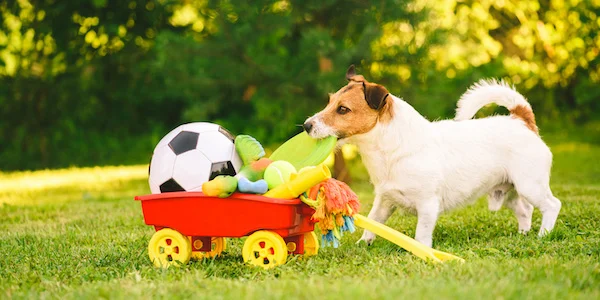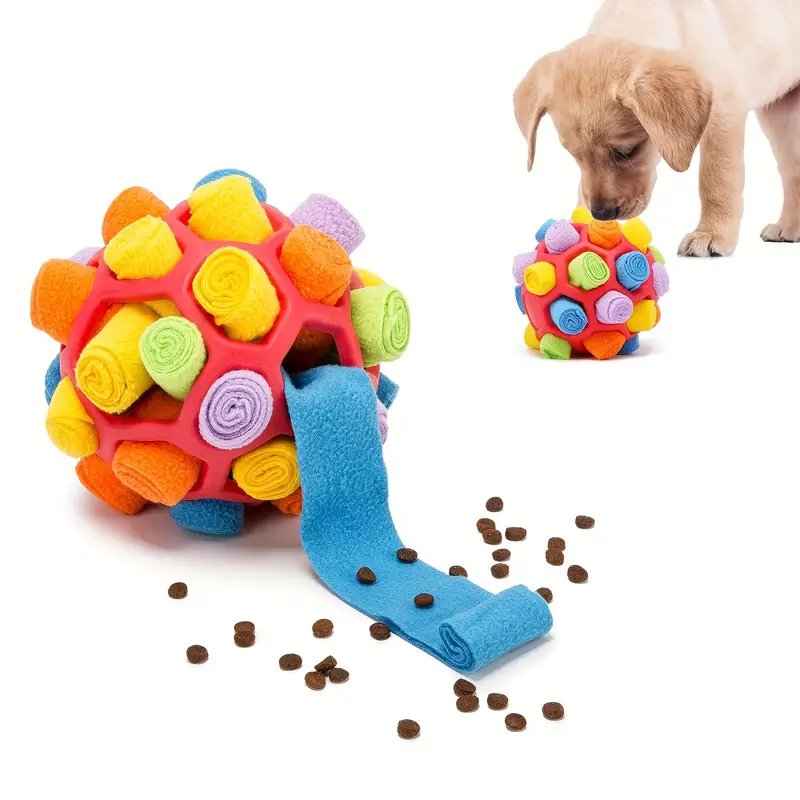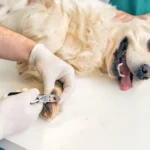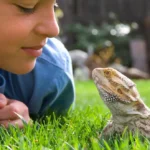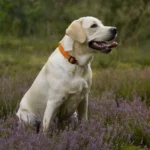In the bustling world of pet care, enrichment toys for dogs have become a game-changer. These ingenious playthings aren’t just about fun; they’re vital tools for keeping our furry friends mentally sharp and physically active. Whether you’re a new pet parent or a seasoned dog lover, understanding the world of dog toys, especially those designed for enrichment, can transform your pup’s life. Let’s dive into the fascinating realm of canine cognitive stimulation and discover how the best enrichment toys for dogs can make tails wag with delight.
Why Dog Enrichment Matters
Picture this: You’re stuck at home with nothing to do. No books, no TV, no smartphone. Sounds boring, right? That’s how our dogs feel when they lack mental stimulation. Enrichment toys for dogs are the antidote to canine boredom and the key to a happier, healthier pet.
Dogs are intelligent creatures with a natural drive to explore, problem-solve, and play. In the wild, they’d spend hours foraging, hunting, and interacting with their environment. Our domesticated pups still have these instincts, but their cushy home life doesn’t always provide outlets for these behaviors. That’s where enrichment toys come in.
“A mentally stimulated dog is a happy dog,” says renowned dog trainer, Emma Johnson. “Enrichment toys can prevent destructive behaviors, reduce anxiety, and even slow cognitive decline in older dogs.”
The benefits of using enrichment toys are numerous:
- Improved cognitive function
- Reduced stress and anxiety
- Better sleep quality
- Enhanced problem-solving skills
- Stronger bond between dog and owner
Types of Enrichment Toys for Dogs
When it comes to dog toys, the options are endless. But not all toys are created equal when it comes to enrichment. Let’s break down the main categories:
1. Puzzle Toys
Puzzle toys are the brainiacs of the dog toy world. They challenge your pup’s problem-solving skills and often dispense treats as a reward. Some popular types include:
- Food-dispensing puzzles: These toys hide treats in compartments that your dog must figure out how to open.
- Interactive game boards: Think of these as doggy board games, with sliding pieces and hidden treat compartments.
- Treat-hiding toys: Soft toys with pockets or holes where you can hide treats for your dog to find.
2. Chew Toys
Chewing is a natural behavior for dogs, and the right chew toy can provide hours of enrichment. Look for:
- Durable rubber toys: Brands like Kong offer tough toys that can be stuffed with treats.
- Dental chews: These help clean teeth while providing mental stimulation.
- Rope toys: Great for tug-of-war and solo chewing sessions.
3. Plush Toys
While not as durable as other options, plush toys can still offer enrichment:
- Squeaky toys: The noise provides auditory stimulation.
- Crinkle toys: The sound and texture appeal to a dog’s senses.
- Stuffed toys with hidden features: Some plush toys have smaller toys hidden inside, providing an extra layer of discovery.
4. Fetch and Tug Toys
These classics double as great exercise tools:
- Balls and frisbees: Perfect for a game of fetch in the park.
- Tug ropes: Ideal for interactive play that strengthens your bond.
- Launcher toys: These help you throw balls farther, giving high-energy dogs a good workout.
Choosing the Right Enrichment Toys for Your Dog
Selecting the perfect enrichment toy isn’t a one-size-fits-all affair. Consider these factors:
- Size and breed: A toy that’s too small could be a choking hazard, while one that’s too large might be frustrating.
- Play style: Is your dog a gentle nibbler or an aggressive chewer? Choose accordingly.
- Safety: Always opt for toys made from non-toxic materials and watch for any signs of wear and tear.
Here’s a handy table to guide you:
| Dog Size | Recommended Toy Types | Safety Considerations |
|---|---|---|
| Small | Small puzzle toys, soft plush toys | Avoid toys with small parts |
| Medium | Interactive balls, medium-sized chew toys | Check durability regularly |
| Large | Large Kong toys, rope toys, sturdy puzzle feeders | Opt for toys designed for power chewers |
DIY Dog Enrichment Toys
Who says you need to break the bank to keep your pup entertained? With a little creativity, you can create enrichment toys from items you already have at home. Here are some ideas:
- Muffin Tin Puzzle: Place treats in a muffin tin and cover each cup with a tennis ball. Your dog will have to figure out how to remove the balls to get the treats.
- Water Bottle Toy: Remove the cap and label from a plastic water bottle. Put a few small treats inside and let your dog figure out how to get them out.
- Frozen Kong: Fill a Kong toy with a mixture of wet dog food, peanut butter, and treats. Freeze it for a long-lasting challenge.
- Snuffle Mat: Create a mat with fleece strips tied to a rubber mat. Hide treats among the fleece for your dog to sniff out.
Remember, always supervise your dog with homemade toys to ensure safety.
Incorporating Enrichment Toys into Your Dog’s Routine
Consistency is key when it comes to enrichment. Here’s how to make the most of these toys:
- Create a toy rotation: Keep things fresh by switching out toys every few days.
- Use toys for training: Incorporate puzzle toys into training sessions as rewards.
- Designate playtime: Set aside specific times each day for focused play with enrichment toys.
Top Enrichment Toys for Dogs in the USA
While there are countless options on the market, some stand out as fan favorites:
- Kong Classic: A versatile rubber toy that can be stuffed with treats.
- Nina Ottosson Dog Brick: A challenging puzzle toy that slides and flips to reveal treats.
- Outward Hound Hide-A-Squirrel: A plush tree stump with squeaky squirrels to find and remove.
- Starmark Bob-A-Lot: A weighted toy that dispenses treats as your dog knocks it around.
- West Paw Zogoflex Qwizl: A durable chew toy that can hold treats or spreads.
The Science Behind Dog Enrichment Toys
Research has shown that mental stimulation through enrichment toys can have profound effects on a dog’s well-being. A study published in the Journal of Veterinary Behavior found that dogs given regular access to puzzle feeders showed reduced stress behaviors and increased problem-solving abilities.
Dr. Lisa Radosta, a board-certified veterinary behaviorist, explains, “Enrichment toys tap into a dog’s natural foraging instincts. This not only provides mental stimulation but can also help reduce anxiety and prevent the development of certain behavioral issues.”
Expert Tips for Maximizing Enrichment Toy Benefits
To get the most out of your dog’s enrichment toys, consider these expert tips:
- Start simple: If your dog is new to puzzle toys, begin with easier ones to build confidence.
- Supervise play: Always watch your dog with a new toy to ensure they’re using it safely.
- Rotate regularly: Keep a variety of toys and switch them out to maintain interest.
- Use high-value treats: For challenging puzzles, use extra-tasty treats as motivation.
- Be patient: Some dogs may take time to figure out new toys. Offer encouragement and assistance if needed.
Case Study: Max’s Enrichment Journey
Max, a 3-year-old Labrador Retriever, was struggling with destructive behavior when left alone. His owner, Sarah, decided to try incorporating enrichment toys into his routine.
Before: Max would chew furniture and bark excessively when Sarah was at work.
Intervention: Sarah introduced a rotation of puzzle toys, including a treat-dispensing ball and a snuffle mat. She also began using a frozen Kong toy when leaving for work.
After: Within two weeks, Max’s destructive behavior decreased significantly. He was more relaxed when left alone and showed increased problem-solving skills during playtime.
This case demonstrates how enrichment toys can provide much-needed mental stimulation and help alleviate behavioral issues.
Conclusion: Enhancing Your Dog’s Life with Enrichment Toys
Enrichment toys for dogs are more than just playthings; they’re tools for a happier, healthier canine companion. By challenging your dog’s mind, satisfying their natural instincts, and providing an outlet for energy, these toys can transform your pup’s daily life.
Remember, every dog is unique. What works for one may not work for another. The key is to experiment with different types of enrichment toys and observe what truly engages your furry friend. Whether it’s a complex puzzle feeder or a simple homemade toy, the goal is to keep your dog’s tail wagging and mind working.
So, why wait? Start exploring the world of dog enrichment toys today. Your four-legged friend will thank you with boundless joy and a stronger bond than ever before.
FAQs About Dog Enrichment Toys
- How often should I introduce new enrichment toys to my dog?
Aim to rotate toys every few days to keep things interesting. Introduce a new toy every few weeks. - Can enrichment toys help with separation anxiety?
Yes, they can provide distraction and comfort when you’re away, potentially easing anxiety. - Are there enrichment toys suitable for senior dogs?
Absolutely! Look for softer puzzle toys or scent-based games that are easier on aging joints. - How do I clean and maintain dog enrichment toys?
Most can be washed with soap and water. Always follow manufacturer instructions and inspect regularly for wear. - Can enrichment toys replace regular exercise for dogs?
While great for mental stimulation, enrichment toys shouldn’t replace physical exercise. A balance of both is ideal for your dog’s overall health.
Remember, the world of enrichment toys for dogs is vast and exciting. Whether you’re looking for the best enrichment toys for dogs or simple dog toys to start with, there’s something out there for every pup. And for those high-energy breeds, don’t forget to explore gaming toys for dogs that can provide both mental and physical stimulation. Happy playing!

